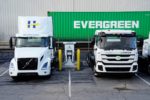Archives
Business, Feature, Freight News
Report: $1 Trillion Needed to Electrify US Truck Fleet
[ March 22, 2024 // Gary G Burrows ]Converting the U.S. commercial truck fleet to full electrification would require nearly US$1 trillion in infrastructure investment alone, according to a new report from Roland Berger, released by the Clean Freight Coalition, or CFC, a Swiss-based international management consultancy, on March 19.
The study, which forecasts a realistic infrastructure buildout for the electrification of medium- and heavy-duty commercial vehicles, which the coalition says exposes a massive investment gap as state and federal policymakers mandate increased adoption rates of battery-electric commercial vehicles.
“This study thoroughly examines the issues surrounding the infrastructure buildout necessary to electrify commercial vehicles, and it clearly shows how the heavy-duty vehicle industry’s needs are vastly different not just from other sectors of our economy, but from each other,” said CFC Executive Director Jim Mullen. He credited Roland Berger for outlining the challenges electrifying the supply chain poses “as the industry and nation continue working toward our shared goal of reducing trucking’s impact on the environment.”
Key Findings
Among its findings, Roland Berger said:
- Preparing today’s commercial vehicle fleet for electrification would require the commercial vehicle industry to invest upwards of US$620 billion in charging infrastructure alone, including chargers, site infrastructure and electric service upgrades.
- Utilities would need to invest US$370 billion to upgrade their grid networks to meet the demands of just commercial vehicles.
This nearly US$1 trillion expenditure does not account for the cost of new battery-electric trucks, which according to market research can be two to three times more expensive than their diesel-powered equivalents. For example, a diesel Class 8 truck costs roughly US$180,000, while a comparable battery-electric truck costs over US$400,000.
“An industry with a yearly turnover of about US$800 million and a profit margin around 5 percent cannot invest US$620 million without financial support or a significant increase in rates,” said Wilfried Aulbur, senior partner with Roland Berger.
The approach towards electrification focusing initially on the easier vehicle segments as well as exploring how fleets operate and potentially adjust; forming better cooperation and planning across industries and governments; and an openness to alternative technology paths to decarbonizing the heavy-duty segment, Aulbur said.
The CFC, which consists of transportation stakeholders across the trucking and motorcoach industries, says that policymakers must address these cost concerns and infrastructure hurdles to make an electrified supply chain function smoothly for the American economy.
The study found that while medium-duty vehicles will face fewer roadblocks, economic and operational constraints make electrification very challenging for the heavy-duty segment, the CFC said. The study further outlined significant improvements needed in battery range and charging infrastructure capabilities to support the electrification of long-haul vehicles.
A one-page summary of the report is available at https://tinyurl.com/4me9hkxh. A fuller summary of Roland Berger’s work can be found at https://tinyurl.com/kme8bpkx.
Industry Response
“You don’t overcome obstacles by ignoring them, which this study lays out the high investment costs required to electrify the commercial vehicle industry,” said Chris Spear, president and CEO of the American Trucking Associations. “Policymakers should take note that pursuing technology-neutral solutions can deliver operational savings and emissions reductions at a fraction of the cost. A real-world understanding of the path to our shared goal of zero emissions is needed, but unrealistic timelines and expectations will break the bank.”
American Truck Dealers President Laura Perrotta said U.S. commercial dealers have already spent nearly US$1 billion this decade to sell and service EVs – nearly $1 billion in this decade. “Unfortunately, dealers are faced with inadequate charging infrastructure, delays when installing chargers due to parts shortages and utility workload challenges, and unaffordable upgrades required to meet new electricity demands.”
Lisa Mullings, president and CEO of NATSO, an association of fuel providers, said the report “clearly demonstrates that policy must not depend on a single technology to reduce the carbon emissions from commercial trucks.”
The US$620 million price tag to supply necessary charging stations to fuel commercial trucks will fall upon truck stops, fleets and ultimately consumers.
“We need to overcome the many challenges impeding businesses’ ability to recoup these vast investments. This report underscores the critical need for policymakers to incentivize the existing low-carbon fueling options available today, including renewable diesel and biodiesel, while the industry implements longer-term options.”
National Motor Freight Traffic Association Executive Director Debbie Sparks said: “As representatives for the less-than-truckload segment of the industry, the transition to zero emission trucks is a paramount concern to our members; if not done in a sustainable and affordable fashion, it will negatively impact their businesses, as well as the overall supply chain.”
National Tank Truck Carriers, President and CEO Ryan Streblow said Roland Berger’s report “reinforces the tank truck industry’s concerns on the current aggressive and unrealistic regulatory approach to zero emissions. We will continue to face major electrification concerns in the tank truck industry – excess weight, limited range, and safety. … Before flipping a switch, we need to ensure there is a scalable and affordable energy source in place to allow the tank truck industry to serve those when they need it the most.”

Tags: Clean Freight Coalition










